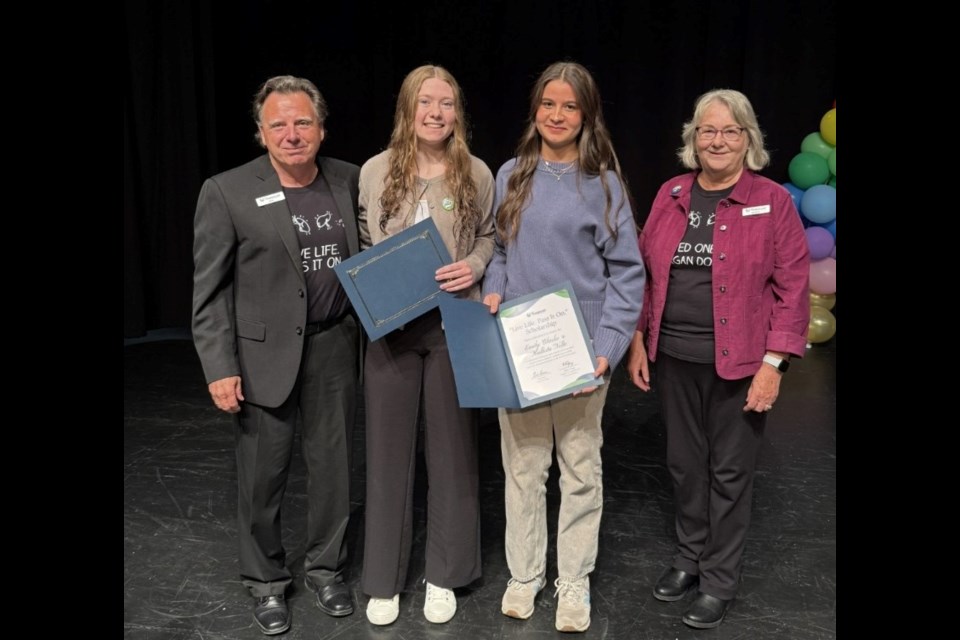Two minutes is all it takes to become registered as an organ donor.
That two minutes from each person who completes the online form can end up saving eight lives, as Prince George students Kallista Nolte and Emily Clarke learned as organizers of an award-winning organ donation awareness program at Duchess Park Secondary School.
Nolte and Clarke’s extraordinary effort to create more transplant sources for people desperately waiting for that call from the hospital that could save their lives did not go unnoticed.
They are among four student awareness projects in the province chosen by BC Transplant Live Life and Pass It On scholarship award, to be presented at the Duchess Park awards ceremony at the school on Thursday, June 12.
While Clarke and Nolte were organizing their day-long event to promote organ donation they learned one of the Duchess Park teachers, Adrian Borshoi, was a transplant recipient who received a donated kidney.
Nolte drew personal motivation from her aunt, who lives with a genetic disorder, polycystic kidney disease, which carries a 50 per cent likelihood that she will need a kidney transplant at some point in her life
“Our goal was not only to spread short-term awareness, but to create a lasting legacy to honour and support this cause,” said Clarke, in their joint scholarship submission.
Knowing green is the official colour of organ and tissue donation, the two Grade 11 students decorated their school with green streamers from stairways and railings, inflated green balloons in prominent places throughout the school and encouraged everyone to wear green shirts. They handed out beaded necklaces and painted the faces of students green as they arrived for their morning classes.
Their interactive display asked students to write down the names of people they would want to save with their own donated organs to give someone a second chance at life. They hung posters to inform students and school staff that a simple two-minute act of filling out a donor card can save a life down the road and how many lives (eight) can potentially be saved from each organ donor.
They also highlighted that at any given time 4,400 Canadians are waiting for an organ transplant and that 250 people die each year waiting for a transplant.
The two students posted a story board that included photos of people who told about their personal experinces as organ recipients, live donors and the parents of deceased donors. A video shown to the entire student population featured a clip from Borshoi talking about how quality of life has improved since he received his transplanted donor kidney.
Nolte and Clarke thought the best way to get students thinking about the merits of organ donation was to get them in an lunch-hour activity. They formed teams of two to each race one lap around the school building while carrying an egg in a spoon and placing that egg in a cup as fast as possible to demonstrate the real -life urgency of matching transplanted organs and tissue with waiting patients.
“After this was finished, we circulated throughout the school with green sweets,” said Clarke. “We spread the message ‘happy green shirt day’ while we did this. With each new table or class we went in to, you could see the student’s faces light up. This reinforced what we were celebrating, as students will always pay attention when it involves candy. We suggested going to BC Transplant website with a parent to learn more.
“There are many people in our school who don’t know what organ donation really is, or how the process works. We hope this led to countless individuals being open to registering and saving lives.”
Nolte and Clarke are the first team recipients of the BC Transplant Live Life and Pass It On scholarship and they will split the $1,500 award.
Divya Thakor, community engagement co-ordinator for BC Transplant, said Nolte and Clarke’s awareness project stood out as an obvious choice.
“They did such a great job at getting creative with their project and the part of it that what we really loved was they had this big poster which asked, “Who would you save if it came down to it,’ and so students came up and wrote their friends, their family, their dogs,” said Thakor.
“Ultimately, organ donation is registering your decision so you can give someone else a second chance at life. They had the video they created and they interviewed a teacher who is a kidney recipient so it allows students to hear from someone who actually received a transplant, which is great to get the wheel turning in their minds to understand the importance of getting registered.”
Donor organs that can be transplanted include the heart, lungs, liver, kidneys, pancreas, and intestines. Corneas, skin, bone, tendons, heart valves, and the white part of an eye (sclera) are tissues that are transplanted.
About 1.6 million British Columbians have registered for the program.
Thakor said it’s no longer possible to just sign your driver’s licence to register as a donor. It you haven’t already signed up it requires going to the provincial website www.registeryourdecison.ca and inputting your personal health care identification number, Donors can check to see if they are already registered by going to www.checkyourdecision.ca.
“We find there is a big need for education and exposure and so we’re really trying to start these conversations at schools so that the students get to learn about organ donation,” said Thakor. The more conversations, the more lives will be saved.”



